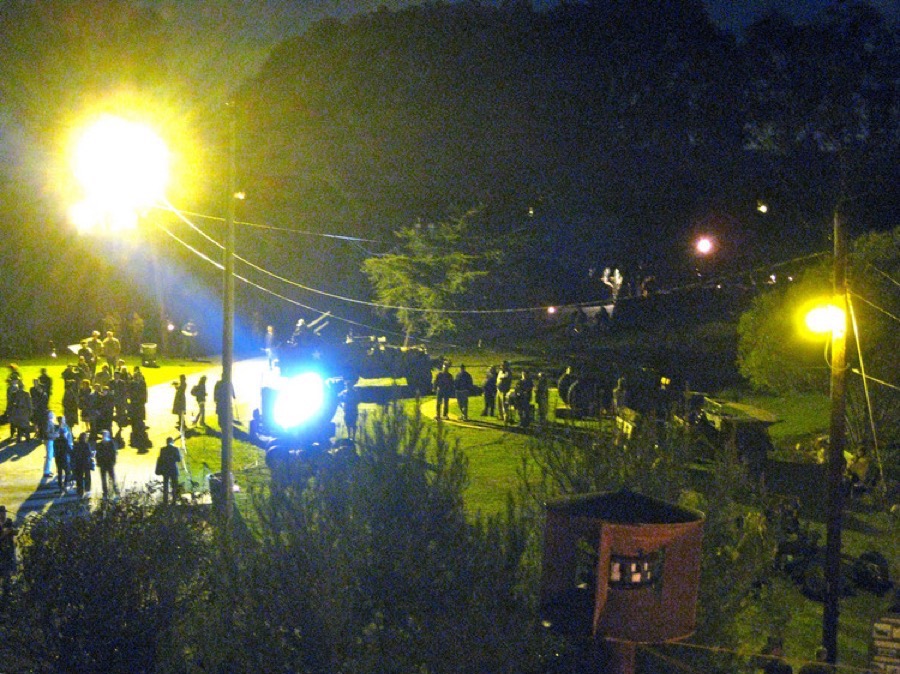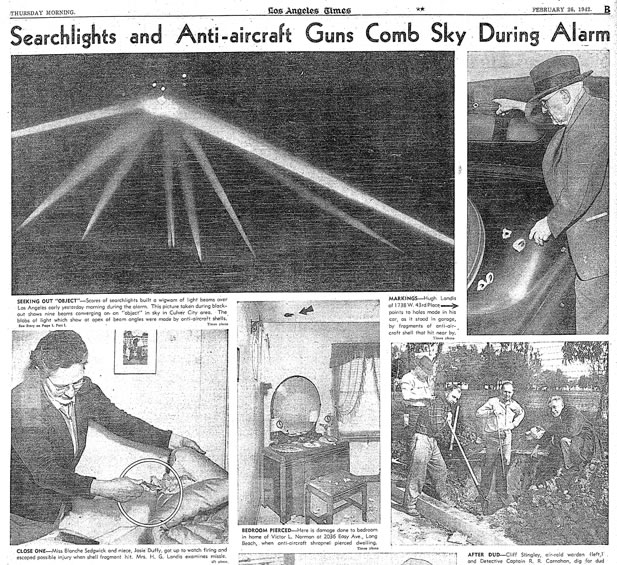A Great Happening Over The Skies Of Los Angeles
Did You Know? - The Battle of Los Angeles is the name given by contemporary news agencies to a sighting of one or more unidentified flying objects which took place from late February 24 to early February 25, 1942 in which eyewitness reports of an unknown object or objects over Los Angeles, California, triggered a massive anti-aircraft artillery barrage. The Los Angeles incident occurred less than three months after America's entry into World War II as a result of the Japanese Imperial Navy attack on Pearl Harbor. See video's of the event


Please select a year to join the fun!

We are under attack!
The Great Los Angeles Air Raid
On the night and early morning of February 24 and 25, 1942, a singular event unfolded in the skies over Southern California – the continental United States was attacked by an enemy... or was it? The reports of this vary, from a squadron of Japanese bombers, a weather balloon, and even alien spacecraft, and the subsequent government conspiracies that followed. We do know that something happened; too many people witnessed the event to dispute that fact, but what really happened?
My parents we in Los Angeles that night living in West Los Angeles and they remember the blackouts and driving with lights off in the early evening. The radio carried some of the details but TV was still a glimmer in people's eyes.

Los Angeles Times
The newspaper reports from Wednesday morning of the 25th, varied wildly. The Los Angeles Examiner said that civilian witness had put the number of planes at fifty, and that three of them had been shot down over the ocean, although there was no immediate confirmation of this from Army or Navy sources. The Los Angeles Times headlines blared "L.A. Area Raided", and "Jap Planes Peril Santa Monica". The 77th street police station reported a downed aircraft near 180th street and Vermont. By the light of day what could be put together is that at approximately 3:10 am anti aircraft batteries that had been stationed around Southern California's defense plants began firing their 12.8 - pound explosive charges and kept this up for fifty minutes, eventually launching over 1,400 of them. The curious thing was that not a single bomb had been dropped on the city, and not a single scrap of any aircraft was ever recovered. In fact, the only casualties were caused by the falling shrapnel and unexploded ordinance that rained in a 40 mile arc from Santa Monica to Long Beach.

Early 1942 was a time of much uncertainty to many Southern Californians. Pearl harbor had been attacked just a few months earlier and many were suspicious of the large Japanese population living so close to some of Americas most strategic industries. Just twenty-four hours earlier an enemy submarine had attacked an oil refinery in Goleta, a sleepy coastal town just one hour north of Los Angeles. Although the shelling did less than $500 in damage and caused no casualties, this attack was widely reported in Los Angeles and caused some alarm among the citizenry. That an enemy submarine could surface a couple hundred yards from shore and lob shells onto the beach for thirty minutes was cause for consternation. (The fact that they appeared to be incredibly bad shots was lost on most people at the time.)
The day after the air raid, in Washington, Navy Secretary Frank Knox was quoted as saying "as far as I know the whole raid was a false alarm and could be attributed to jittery nerves". But did any of those one million witnesses actually see an enemy aircraft? Many will point to some sort of government cover-up or conspiracy. However, as we were at war, still stinging from Pearl Harbor, it is reasonable to assume that the United States government would want to keep an enemy attack quiet.

The physical evidence points to no aircraft at all being up there that night. As one witness, Jack Illfrey, a young P38 pilot assigned to the 94th aero squadron stationed at Long Beach Airport reported, "We pilots prayed to the good Lord above that we wouldn't be sent up in that barrage, enemy or not.
Most everyone saw or imagined something – Japanese Zero's, P34's, Japanese Betty bombers. We were not sent up". So not even American interceptors were sent up that night, thankfully, as they may likely have become victims of "friendly fire". Years later it was discovered that a coastal radar station had indeed seen an inbound blip on their radar screens that night. But was this actually enemy aircraft?
Those were scary days.
